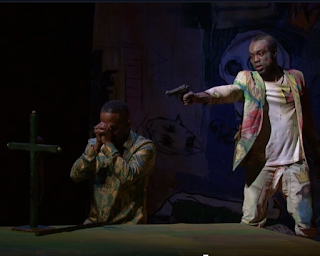Changing Interpretations Over Time: T S Eliot
We've already met TS Eliot (1888 – 1965) - in the first critical essay that I gave out after we had read the opening scene. Now would be a good time to return to that essay, and make a kind of 'double entry' for this critic.
Thomas Stearns Eliot won the Nobel Prize for Literature in 1748, and is considered one of the giants of modern literature. He is best known as a poet, famous for 'The Waste Land' and 'The Love Song of J. Alfred Prufrock' but was also a literary critic, dramatist, and editor and publisher. He was born in St. Louis, Missouri but relocated to England in 1914 at the age of 25. He was a contemporary of Virginia Woolf, and they were friends for more than twenty years. Here they are together, probably having a good old chinwag about Modernism, or, perhaps, the price of tea.
T. S. ELIOT: from 'Hamlet' 1919
Few critics have ever admitted that Hamlet the play is the primary problem, and Hamlet the character only secondary. And Hamlet the character has had an especial temptation for that most dangerous type of critic.... These minds often find in Hamlet a vicarious existence for their own artistic realization.
Such a mind had Goethe, who made of Hamlet a Werther; and such had Coleridge, who made of Hamlet a Coleridge; and probably neither of these men in writing about Hamlet remembered that his first business was to study a work of art. ...
The Hamlet of Shakespeare will appear to us very differently if, instead of treating the whole action of the play as due to Shakespeare's design, we perceive his Hamlet to be superposed upon much cruder material which persists even in the final form.
We know there was an older play by Thomas Kyd, that extraordinary dramatic (if not poetic) genius who was in all probability the author of two plays so dissimilar as the Spanish Tragedy and Arden of Feversham; and what this play was like we can guess from three clues: from the Spanish Tragedy itself, from the tale of Belleforest upon which Kyd's Hamlet must have been based, and from a version acted in Germany in Shakespeare's lifetime which bears strong evidence of having been adapted from the earlier, not from the later, play. From these three sources it is clear that in the earlier play the motive was a revenge motive simply; that the action or delay is caused, as in the Spanish Tragedy, solely by the difficulty of assassinating a monarch surrounded by guards; and that the 'madness' of Hamlet was feigned in order to escape suspicion, and successfully. In the final play of Shakespeare, on the other hand, there is a motive which is more important than that of revenge, and which explicitly 'blunts' the latter; the delay in revenge is unexplained on grounds of necessity or expediency; and the effect of 'madness' is not to lull but to arouse the king's suspicion. The alteration is not complete enough, however, to be convincing. ... The upshot ... is, we believe, irrefragable: that Shakespeare's Hamlet, so far as it is Shakespeare's, is a play dealing with the effect of a mother's guilt upon her son, and that Shakespeare was unable to impose this motive successfully upon the 'intractable' material of the old play. ...
This, however, is by no means the whole story. It is not merely the 'guilt of a mother' that cannot be handled as Shakespeare handled the suspicion of Othello, the infatuation of Antony, or the pride of Coriolanus. The subject might conceivably have expanded into a tragedy like these, intelligible, self-complete, in the sunlight. Hamlet, like the sonnets, is full of some stuff that the writer could not drag to light, contemplate, or manipulate into art. ...
The only way of expressing emotion in the form of art is by finding an 'objective correlative'; in other words, a set of objects, a situation, a chain of events which shall be the formula of that particular emotion; such that when the extremely facts, which must terminate in sensory experience, are given, the emotion is immediately evoked. If you examine any of Shakespeare's more successful tragedies, you will find this exact equivalence; you will find that the state of mind of Lady Macbeth walking in her sleep has been communicated to you by a skilful accumulation of imagined sensory impressions; the words of Macbeth on hearing of his wife's death strike us as if, given the sequence of events, these words were automatically released by the last event in the series. The artistic 'inevitability' lies in this complete adequacy of the external to the emotion; and this is precisely what is deficient in Hamlet. Hamlet (the man) is dominated by an emotion which is inexpressible, because it is in excess of the facts as they appear. And the supposed identity of Hamlet with his author is genuine to this point: that Hamlet's bafflement at the absence of objective equivalent to his feelings is a prolongation of the bafflement of his creator in the face of his artistic problem. Hamlet is up against the difficulty that his disgust is occasioned by his mother, but that his mother is not an adequate equivalent for it; his disgust envelops and exceeds her. It is thus a feeling which he cannot understand; he cannot objectify it, and it therefore remains to poison life and obstruct action. None of the possible actions can satisfy it; and nothing that Shakespeare can do with the plot can express Hamlet for him.




Comments
Post a Comment